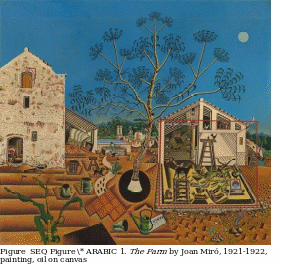
Joan Miró’s artwork The Farm is challenging to enroll in any one movement in painting (Figure 1). The first thing the viewer pays attention to is the primitive realism of the painting, which the artist expresses by imitating children’s drawings. The photographic accuracy of the depicted landscape is unimportant, so the artist focuses on individual details, such as footprints on the path, stones in the right corner of the picture, and cracks in the house (Miró, 1921-1922). Furthermore, there is an evident influence of cubism on the artwork. The house and chicken coop are depicted using clear, straight lines and paler shades (Miró, 1921-1922). Moreover, the painting has prominent surrealistic motifs. For example, the artist depicts not the reality he saw but the one stored in his subconscious. Because of this, there are illogical and absurd objects on the painting, such as a tree in the very center of the image, which grows out of nowhere.
References
Miró, J. (1921-1922). The Farm [painting]. National Gallery of Art, Washington, DC, United States. Web.